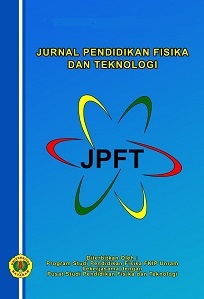Pengembangan Perangkat Pembelajaran Fisika Berorientasi Pada Kreativitas Calon Guru
DOI:
10.29303/jpft.v4i1.442Published:
2018-05-28Issue:
Vol. 4 No. 1 (2018): Januari - Juni 2018Keywords:
Physics learning tools, creativityArticles
Downloads
How to Cite
Downloads
Metrics
Abstract
Learning tools are an important part of learning. Innovative learning tools will help lecturers and students achieve the goals in learning. The purpose of this research is to produce an innovative learning tools oriented to the creativity of preservice physics teachers. The type of research is development research, using DDD-E model: decide, design, develop, and evaluate. Instruments used include physics concept test with multiple choice form, essay-type creativity test, activity observation sheet in Likert scale questionnaire. In this study also conducted empirical testing to measure the effectiveness of learning tools which developed to increase student creativity. The results show that the highest creativity improvement of the experimental class on verbal creativity.References
Cropley, A. (2012). Creativity and education: An Australian perspective. IJCPS-International Journal of Creativity and Problem Solving, 22(1), 9.
Ekasari, R. R., Gunawan, G., & Sahidu, H. 2016. Pengaruh Model Pembelajaran Langsung Berbantuan Media Laboratorium Terhadap Kreatifitas Fisika Siswa SMA. Jurnal Pendidikan Fisika dan Teknologi, 2(3), 106-110.
Gunawan, G., Sahidu, H., Harjono, A., & Suranti, N. M. Y. The Effect of Project Based Learning with Virtual Media Assistance on Student's Creativity in Physics. Cakrawala Pendidikan, (2).
Jackson, L. A., Witt, E. A., Games, A. I., Fitzgerald, H. E., von Eye, A., & Zhao, Y. 2012. ââ¬ÅInformation Technology Use and Creativity: Findings from The Children and Technology Projectââ¬Â. Computers in Human Behavior, 28(2), 370-376.
Jausovec, N., & Jausovec, K. (2011). Brain, creativity and education. The open education journal, 4(1).
Kampylis, P. G., & Valtanen, J. 2010. ââ¬ÅRedefining Creativity ââ¬â Analyzing Definitions, Collocations, and Consequencesââ¬Â. Journal of Creative Behavior, 44 (3), 191-214.
Marisi, A. K. 2007. ââ¬ÅEfektivitas Model Pengukuran Kreativitas dalam Pembelajaran Hemisphere Kanas (HK) untuk Meningkatkan Kreativitas Siswa Kelas V dalam Mata Pelajaran IPA di Sekolah Dasarââ¬Â. Jurnal Penelitian dan Evaluasi Pendidikan, 10(2), 169-190.
Nisrina, N., Gunawan, G., & Harjono, A. (2016). Pembelajaran Kooperatif dengan Media Virtual untuk Peningkatan Penguasaan Konsep Fluida Statis Siswa. Jurnal Pendidikan Fisika dan Teknologi, 2(2), 66-72.
Preckel, F., Holling, H., & Wiese, M. 2006. ââ¬ÅRelationship of Intelligence and Creativity in Gifted and Non-Gifted Students: An Investigation Of Threshold Theoryââ¬Â. Personality and individual differences, 40(1),159-170.
Rawat, K. J., Qazi, W., & Hamid, S. (2012). Creativity and education. Academic Research International, 2(2), 264.
Suranti, N. M. Y., Gunawan, G., & Sahidu, H. (2016). Pengaruh Model Project Based Learning Berbantuan Media Virtual Terhadap Penguasaan Konsep Peserta didik pada Materi Alat-alat Optik. Jurnal Pendidikan Fisika dan Teknologi, 2(2), 73-79
Wyse, D., & Ferrari, A. (2015). Creativity and education: Comparing the national curricula of the states of the European Union and the United Kingdom. British Educational Research Journal, 41(1), 30-47.
Author Biography
Hairunnisyah Sahidu, Program Studi Pendidikan Fisika, Universitas Mataram
License
Authors who publish with Jurnal Pendidikan Fisika dan Teknologi (JPFT) agree to the following terms:
- Authors retain copyright and grant the journal right of first publication with the work simultaneously licensed under a Creative Commons Attribution License 4.0 International License (CC-BY-SA License). This license allows authors to use all articles, data sets, graphics, and appendices in data mining applications, search engines, web sites, blogs, and other platforms by providing an appropriate reference. The journal allows the author(s) to hold the copyright without restrictions and will retain publishing rights without restrictions.
- Authors are able to enter into separate, additional contractual arrangements for the non-exclusive distribution of the journal's published version of the work (e.g., post it to an institutional repository or publish it in a book), with an acknowledgement of its initial publication in Jurnal Pendidikan Fisika dan Teknologi (JPFT).
- Authors are permitted and encouraged to post their work online (e.g., in institutional repositories or on their website) prior to and during the submission process, as it can lead to productive exchanges, as well as earlier and greater citation of published work (See The Effect of Open Access).











